Dec 15, 2025
Dec 15, 2025
This writer, while growing through the teenage, learned from parents and other elders that we Hindus are followers of the Sanatana Dharma which is over ten millennia old and that our civilization and our culture is a product of an eternal way of life which is based on the core principles such as the Vasudhaiva Kutumbakam (whole world is one family), Sarva Dharma Sambhava (All faiths lead to the same destination), Sarve Bhavantu Sukhinah (Let everyone be happy), and many more such moral principles and tenets. In fact, the Hindu scriptures Vedas and Upanishads are rich of such teachings which have traditionally served as the code of social and moral ethics and guiding factors among Hindus for a peaceful and harmonious living and coexistence of people of all faiths and beliefs. In the Hindu way of life, the term Dharma encompasses all aspects of human life which in essence inculcates universal values like duties, rights, laws, conduct, virtues and correct way of living. The term religion from the West with its current connotations was erstwhile unknown to the Sanatani Hindus but now Dharma is loosely translated as religion.
During the last two millennia or so, the planetary human population experienced the evolution of two new dogmatic religions based on the teachings of certain holy books and prophets, which almost entirely changed the world replacing the majority of the earlier prospering civilizations, cultures and belief systems in various parts of the world partly with persuasion but largely engaging through coercion or enticement. This occurred in Europe, and this occurred in Americas, Middle East, and many other parts of the world. The South Asia or the Indian Sub-continent too was heavily affected yet Sanatana Dharma survived but major part of the Far East (Asia) was least influenced mainly due to their difficult access and partly other reasons such as their socio-political order and people’s resistance. These religions viz. the Christianity and Islam are based on the core principle or ethos that only their God (and prophet) and holy books are true and those who do not follow it are sinner (kafir) deserving condemnation. While the main subject of this essay is different but as we proceed through it, we will know the relevance of the aforesaid averment.
Jabalpur – A Sanskardhani
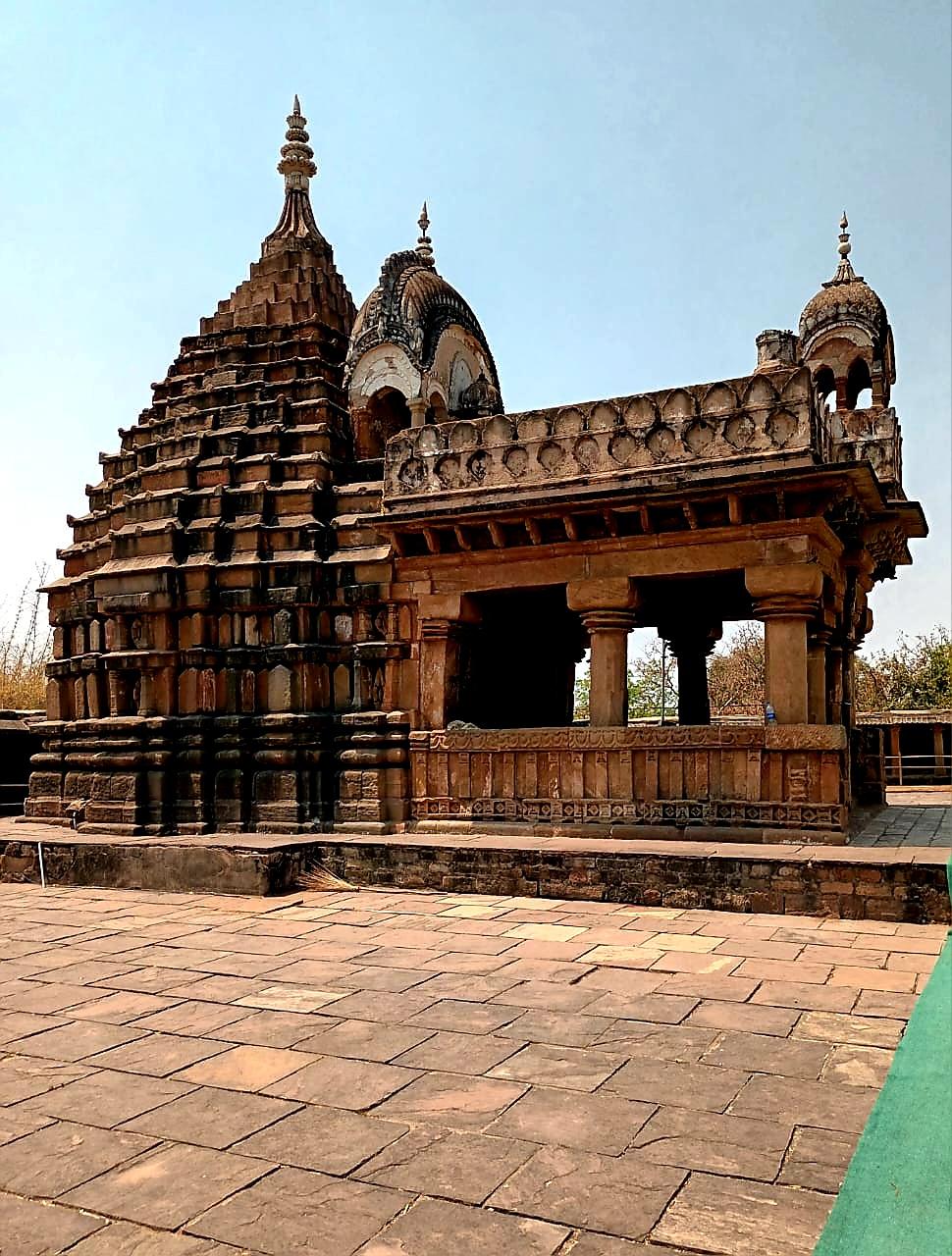
1. Gauri-Shankar Temple
The subject matter of this piece of writing, the Chausath Yogini Temple, relates to Jabalpur which is third largest and important city of the state of Madhya Pradesh in India, often referred to as the Sanskardhani i.e. the cultural capital of the state. While carrying several legacies of the ancient Indian culture, historically the Jabalpur area has been the centre of the glory of the Kalchuri and Gond kingdoms. During the course of history, it bore the brunt of the tyrant Mughal invaders for a considerable period during Emperors Akbar and Aurangzeb rule throughout the medieval times, followed by the Maratha and British rule from the eighteenth century till India became independent in August 1947. Accordingly, the place boasts of a rich cultural heritage which is verily vindicated through its historical sites, vibrant regional festivals, and a rich diversity of religion, traditions, languages, cuisine, festivals, and art forms.
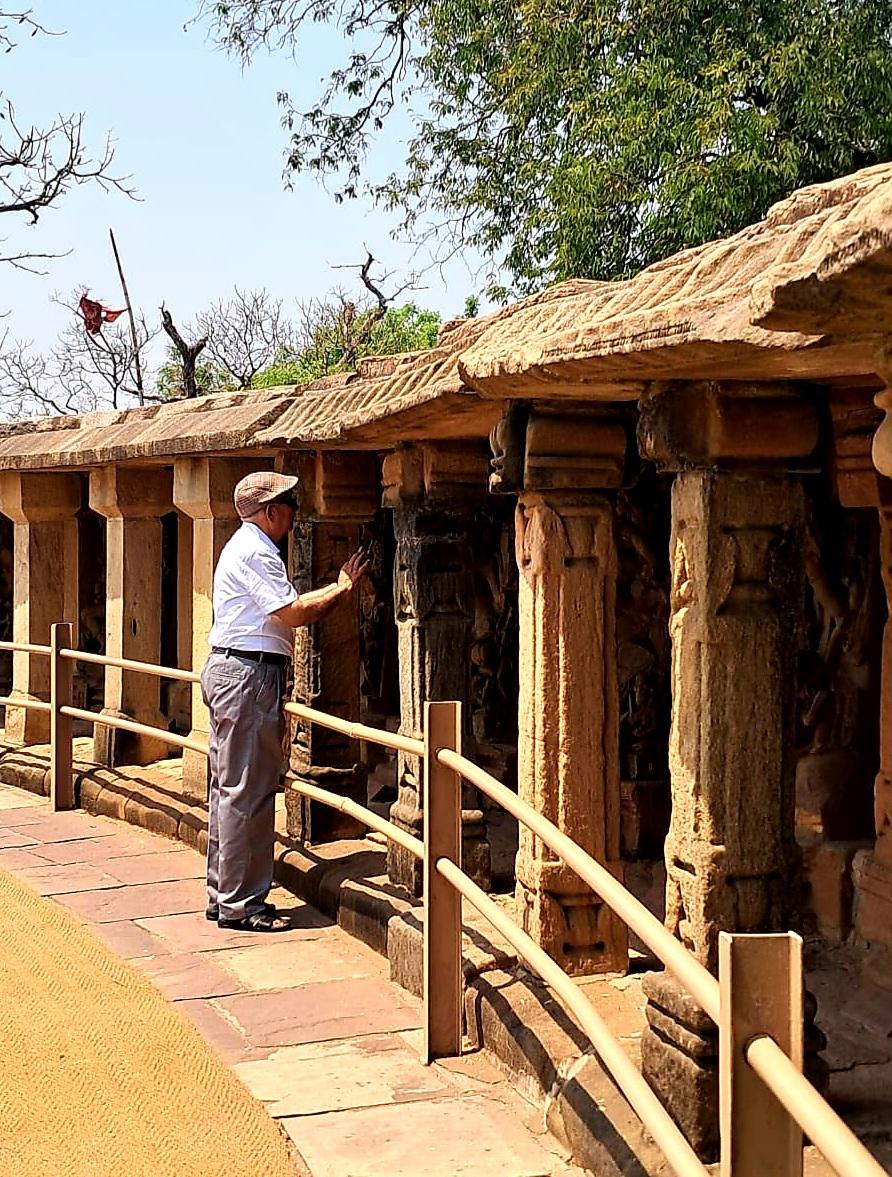
2. Chausath Yogini - Inner Circle & Cells
The ancient Indian texts refer to a famous Hindu saint and philosopher named Jabali Rishi, who is known to have spent long years meditating on the banks of Narmada River in the area. According to a legend, the name Jabalpur is derived after his name which appears quite logical and understandable considering the legacy and richness of the Indian civilization and culture. There are other lesser viable ideas and theories linking the name of the city to a Huna queen of the Kalchuri King Karna as well as an Arabic word ‘Jabal’ meaning huge boulders; such boulders are still found in the region. During the British rule, it was spelled as Jubbulpore and, apparently, it was also the seat of state capital for some time of the Central Provinces (Madhya Pradesh and adjoining areas). Besides, in Hindu mythology, the puranic name of the city also appear as Tripur Tirth after the name of an Asura King Tripurasura.
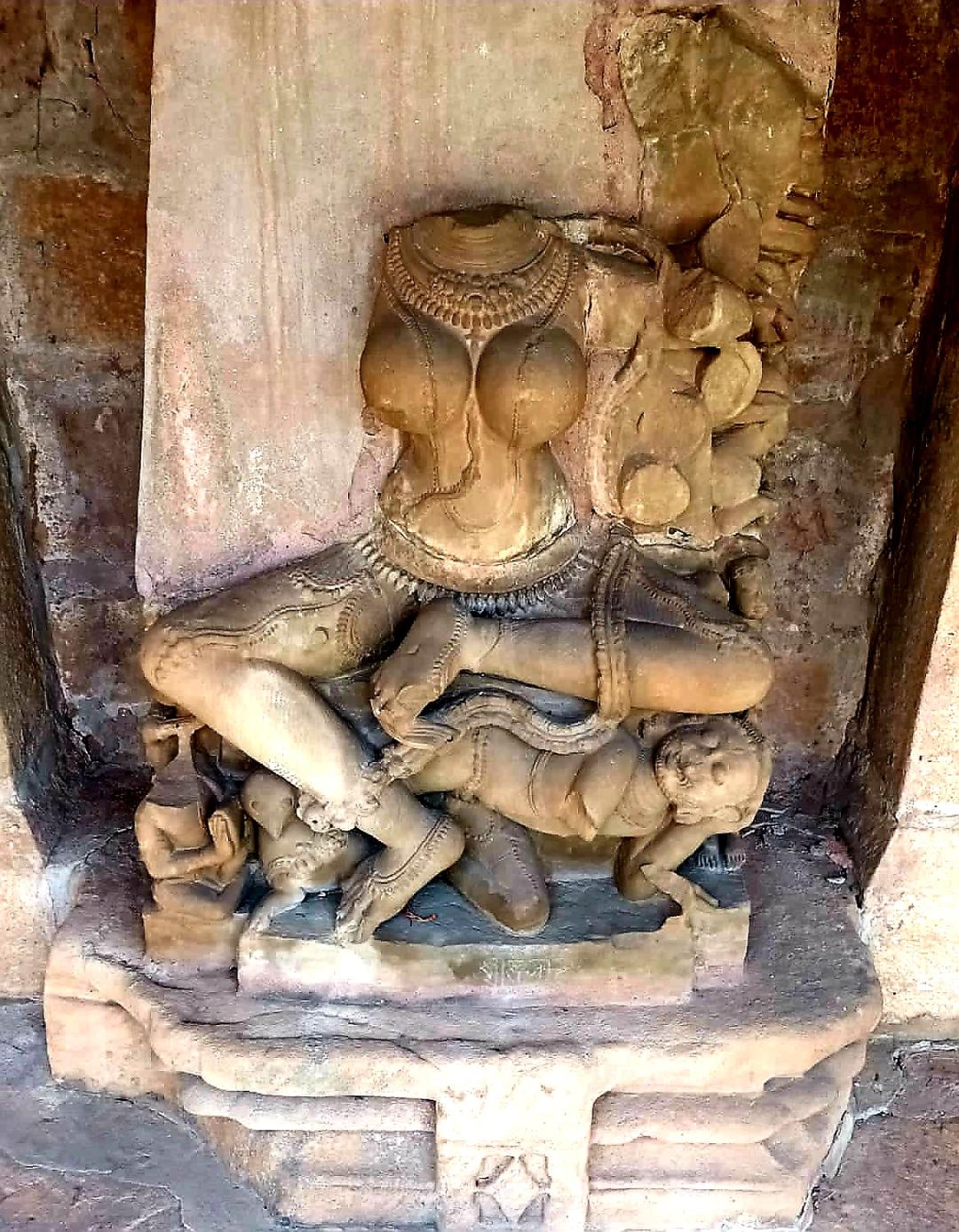
3. Yogini without Head & Hands
References are available from the history that in the ancient Bharatvarsh (India) the region was ruled by kings of the Maurya empire, Satavahana dynasty and Gupta empire. In the later period, more prominent rulers were from the Kalchuri Dynasty from 7th to 13th centuries, and Gond Kingdom 14th century onwards with residual hold over some parts until 1947. Rani Durgavati was a valiant queen (wife of Gond King Dalpat Shah) and remarkable personality in the history of the region (Gondwana), who met her martyrdom fighting with the Mughal army on 24 June 1564. From 1781 CE onwards, it came under the Maratha domain and later on under the British rule till independence of India in 1947. Among the notable cultural and historical sites in Jabalpur include Madan Mahal, marble rocks and Dhuandhar Falls at Bhedaghat, Hanumantal Bada Jain Mandir, Gwarighat, Paat Baba Mandir, Pisanhari Ki Madiya, Balancing rock near Madan Mahal Fort, Shiv Statue at Kachnar City, Rani Durgavati Museum, and the Chausath-Yogini Temple at Bhedaghat.
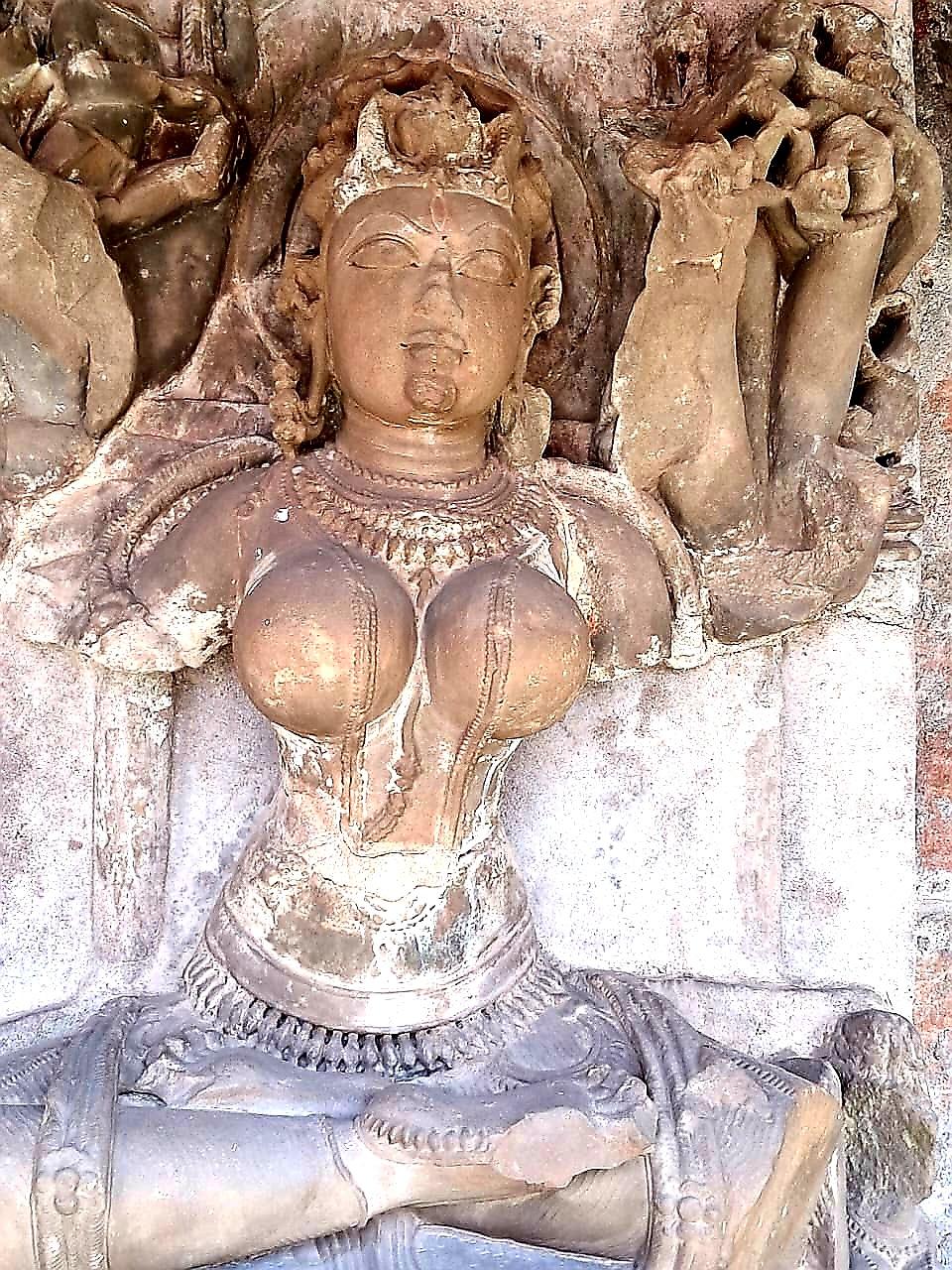
4. Yogini hands chopped & abdomen erased
Madan Mahal is a famous fort built during the reigns of the Gond King Madan Sahi around 1116 CE atop a hill in Jabalpur. Pisanhari Ki Madiya is known so because according to a legend it was founded by a common woman who earned money by grinding grains and it is now better known for its panoramic views and tranquil ambience. A Jabalpur locality known as Kachnar City is a major attraction for a 23-metre-high Lord Shiva statue and the shrine housing a cavern with the replicas of twelve historical Shivlingas. Hanumantal Bada Jain Mandir houses twenty-two shrines with distinct Jain architecture acknowledged as the largest independent Jain Temple in India. Yuvaraja-Deva I (915–945 CE) was among the best known Kalchuri king and one of his ministers namely Golok Simha had key role in founding the aforesaid Chausath Yogini Temple at Bhedaghat, Jabalpur.
Age of Mughal Invasions
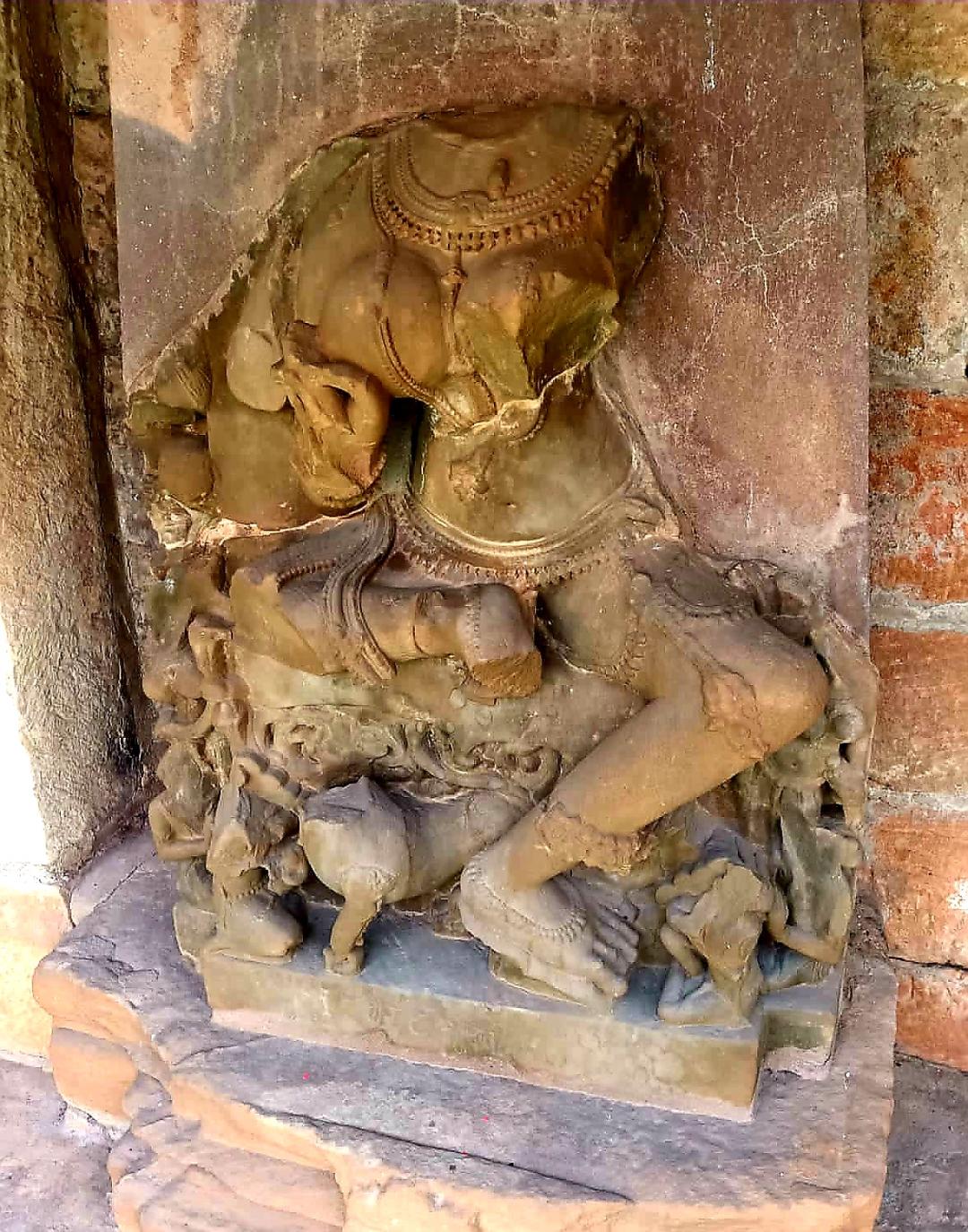
5. Yogini head, hands & left bosom chopped
During the Gond dynasty reign, Jabalpur was part of the Garha Kingdom and there is a distinctly documented occasion when the armed forces under General Khwaja Abdul Majid Asaf Khan of the Mughal Empire invaded the Kingdom in 1564 CE because Emperor Akbar wanted to conquer this region. Rani Durgavati was the queen regent of Gondwana at that time as her husband King Dalpat Shah had died in 1550 CE and their only son and eligible crown prince Vir Narayan was still a minor, just about five years old. So, the Queen administered the kingdom well from 1550 CE to 1564 CE and she is particularly remembered for her skill and bravery of defending Gondwana against the illegitimate designs of the Mughal Empire. Her able deputies Diwan Adhar Kayastha and Minister Man Thakur are known to have assisted her in an effective manner in successful looking after of the administration. Available reports suggest that apprehending Mughal threat, Rani Durgavati had shifted her capital from Singorgarh fort to Chauragarh fort, the latter being more strategic and secure due to its location on the Satpura hill range.
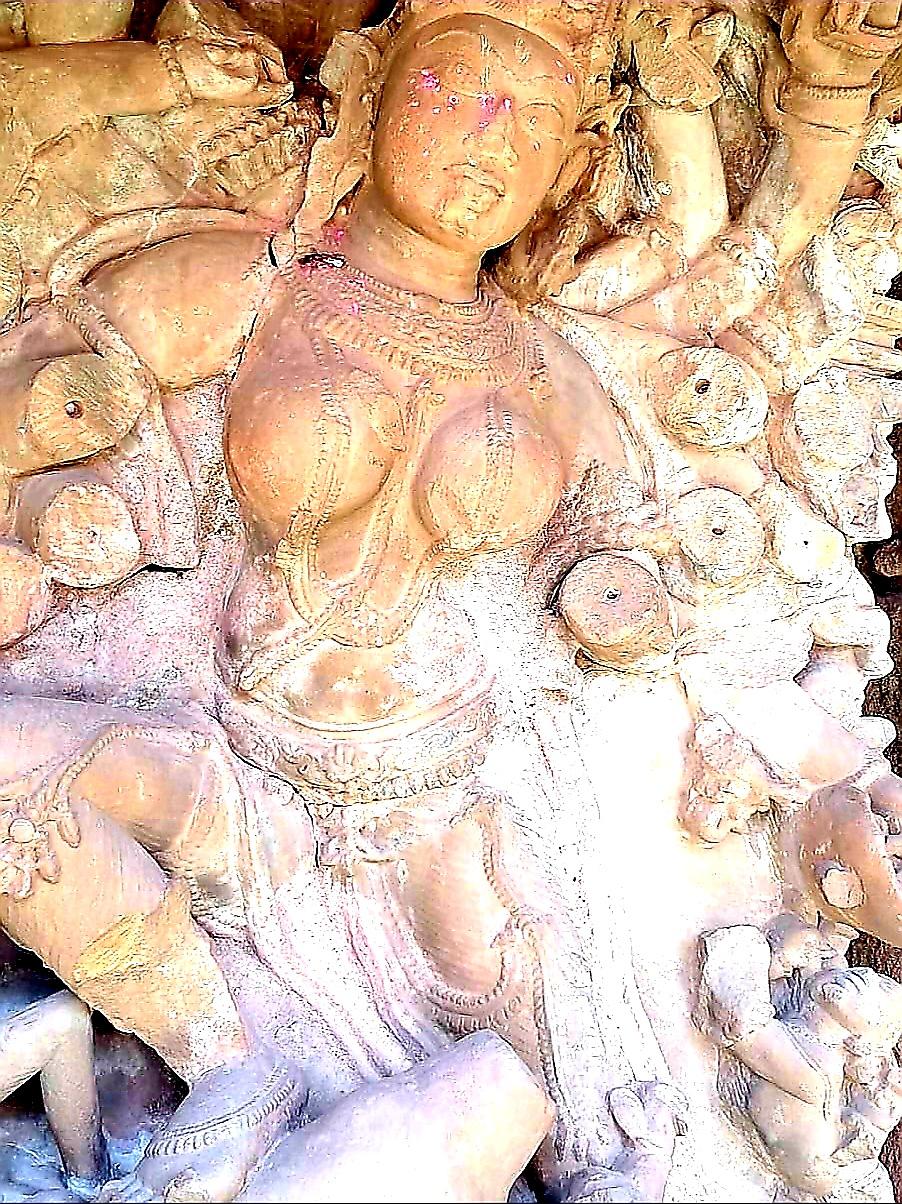
6. Yogini hands chopped, abdomen & legs erased
Earlier, Akbar’s another General Shuja Khan’s son Baz Bahadur had invaded Gondwana in 1556 but his move was repulsed by the queen’s army. During subsequent invasion by the Mughal forces and this time under Asaf Khan, who reportedly had devilish desire for the Rani and her wealth in Gondwana, the two armies engaged in a fierce Battle of Narrai. Knowing beforehand the strength of the Mughal forces from her ministers, Rani Durgavati chose to die putting resistance valiantly rather than living a disgraceful life. Therefore, she personally led her army, and put a strong resistance against the Mughal forces, but despite her bravery and fierce fighting, she lost her battle and life during the war along with her teenage crown prince son. As post-war exploits, the Mughal forces under Asaf Khan gained control over the region and resources, killed a large number of civilians, enslaved women and looted wealth of the state. Rani’s martyrdom is still celebrated as Balidan Diwas on 24 June in the region. Her tomb better known as Chabutar is available near Jabalpur as testimony of the valiant queen’s memory, which was visited by this author too in 2009.
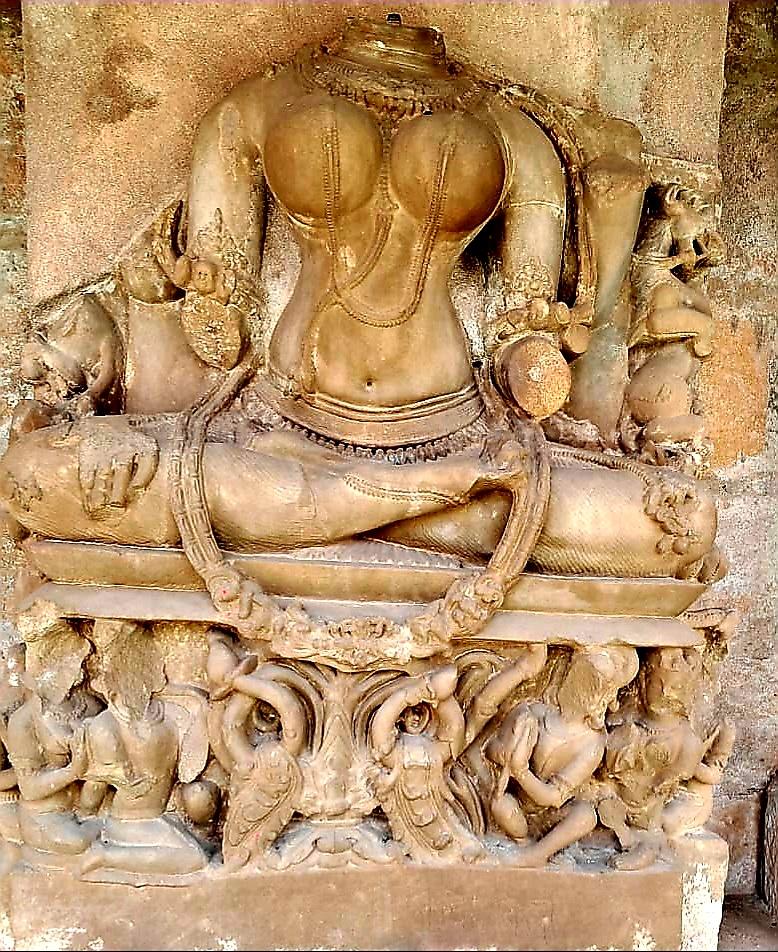
7. Yogini head chopped, hands & leg damaged
In fact, from the 14th to the 18th century, the region was controlled by the rulers of the Gond Dynasty which remained sometimes independent and other times as tributary during the Mughal period. Aurangzeb is known to have remained constantly on war with Hindu kings with a view to gain control over the vast Deccan region while using the parts of Central India as his strongholds. His full-scale invasion of Gondwana region, unlike Akbar, is not well documented in history but time-to-time incursions and wars of Aurangzeb’s forces with Gond rulers indeed occurred mainly in the context of subduing and/or controlling territories besides securing supply lines. The entire Muslim rule in India is also a testimony of Islamic atrocity of non-Muslims, chiefly Hindus, that included genocide, constant killings and conversion, abduction, rape and enslavement of Hindu women, and systematic destruction of the Hindu temples, shrines, institutions, libraries, and so on. The famous temple of Chausath Yoginis at Bhedaghat, Jabalpur is a live testimony of the aforesaid oppressions and excesses believed to be carried out by Aurangzeb.
The Chausath Yogini Temple at Bhedaghat
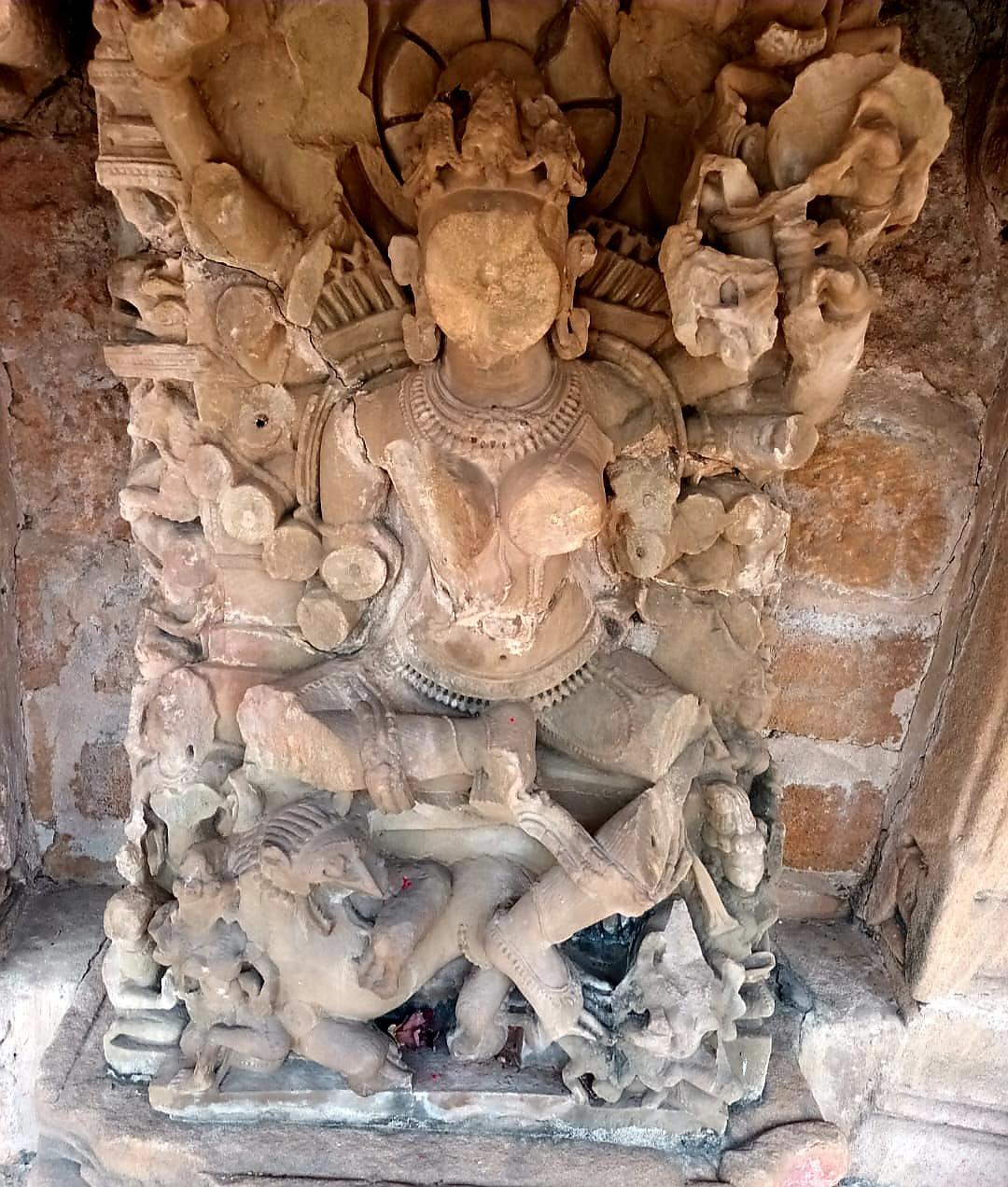
8. Yogini face erased, body damaged
In Sanskrit language, a Yogini is typically a female practitioner of the tantra and yoga as also a formal term to describe the female Hindu and Buddhist spiritual teachers in the Indian sub-continent and Tibet. However, the term is also used for the divine feminine incarnate which is considered a revered aspect of Mahadevi (Goddess Parvati) particularly in a few Yogini temples in India. They are usually a revered group of sixty-four yoginis, varying in their names and attributes. As already mentioned, a Yogini is directly linked to some aspect or attribute of Mahadevi, the ultimate female goddess in several ancient and medieval Hindu texts. Reportedly, there are a total of five Chausath Yogini Temples in India, of which two are in Odisha at Hirapur (near Bhubaneswar) and Ranipur-Jharial (near Titlagarh), and other three are in Madhya Pradesh at Khajuraho, Morena (near Gwalior) and Bhedaghat (Near Jabalpur).
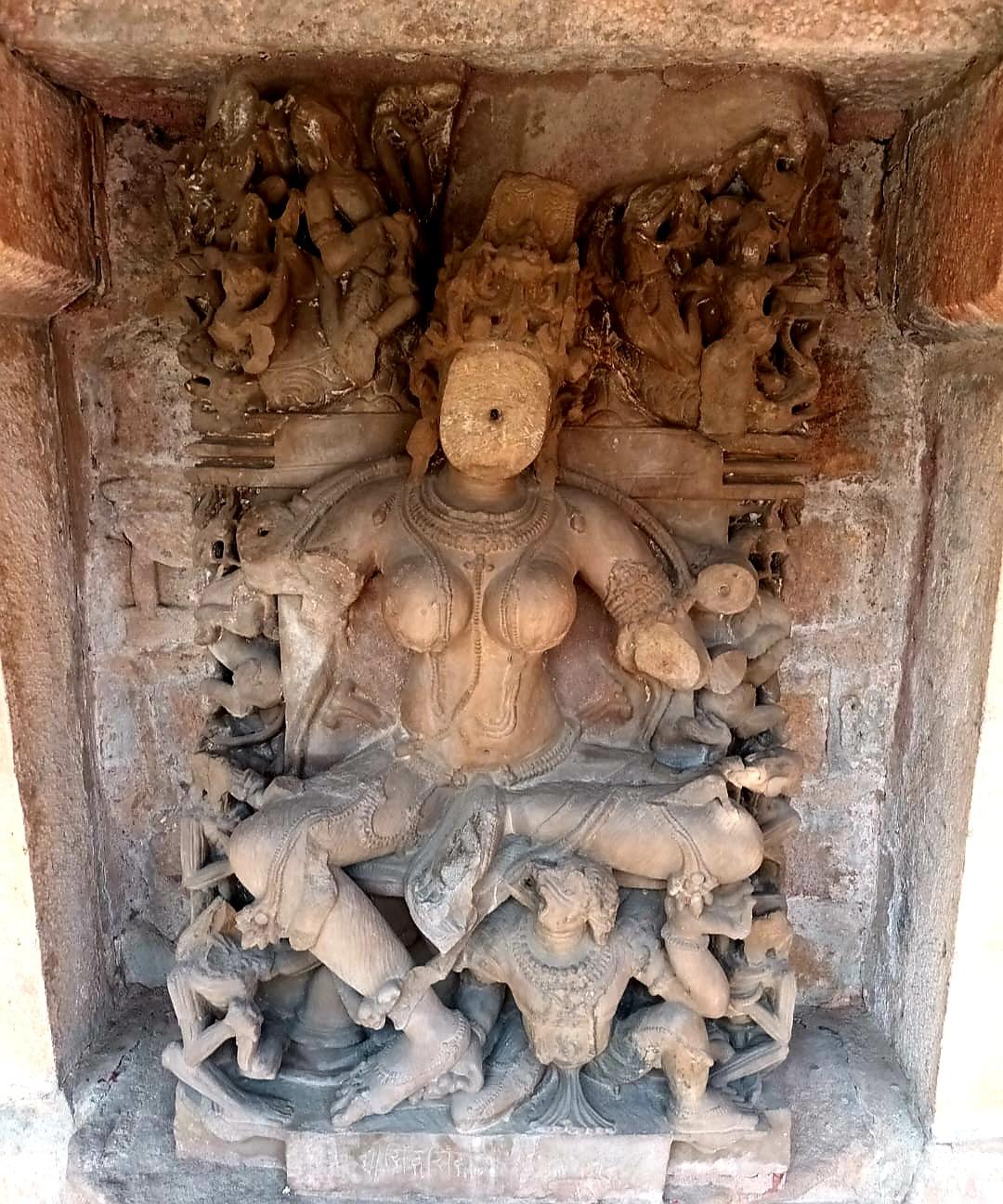
9. Yogini face erased, arms chopped
Topographically, the Chausath Yogini Temple near Jabalpur is situated on a hill top close to the famous Dhuandhar Falls on the River Narmada at Bhedagaht. One needs to climb approximately 150 steps to reach the atop. Of all the aforesaid five shrines, it is the largest Yogini Temple in India made of the local granite, comprising of a circular structure (wall) of an inner diameter of about 116 feet and outer diameter 131 feet. This author did not carry out measurements himself and a few experts/enthusiasts have reported slightly different dimensions of the outer and inner peripheries, too. The inner circle is further divided into 84 equal niches or cells, with three of them serving as gateways to the inner circle. Of the two gateways, the one at the South-East comprises of two adjoining cells while the other at the South-West consists of one cell. The remaining eighty-one cells house statues of mainly Yoginis images inside the perimeter wall along with a walkway. Some experts opine that all the statues are of Yoginis while a few other experts suggest that only sixty-four are Yoginis and the remaining statues represent other Hindu deities.

10. Yogini face erased, hands, legs & bosom chopped
As the temple complex is an acclaimed ASI monument, the Yogini statues have been numbered and named by the Archaeological Survey of India. One can hardly notice any statue intact as most of them are severely damaged and defaced, and in many cases, large chunks of the sculptures are totally missing. The condition of the statues clearly suggests that there was a major event of sabotage and cataclysm at the premises during the history of temple. In some cases, the Yoginis are headless, in other cases they are without face and hands; in certain cases, the breasts have been deliberately chopped off using sharp weapons; one could even find statues of the female deity where entire trunk and head is missing above the waist. In short, the statues of Yoginis present a bizarre scene of various degrees of sabotage or vandalism suggesting that the tyrants and felons deliberately rendered the premises desecrated and profane for the future generations of the devotees (Hindus) to feel embarrassment, shame and pain about what was done to their shrine and deities by the invaders…undoubtedly a heinous act of sin and sacrilege that only people with the demonic attributes would indulge in. Here only a few images revealing the gory and sordid details of what the Islamic invaders of the Mughal era did to this magnificent temple of the Hindu faith but also representative of their beautiful art and culture.
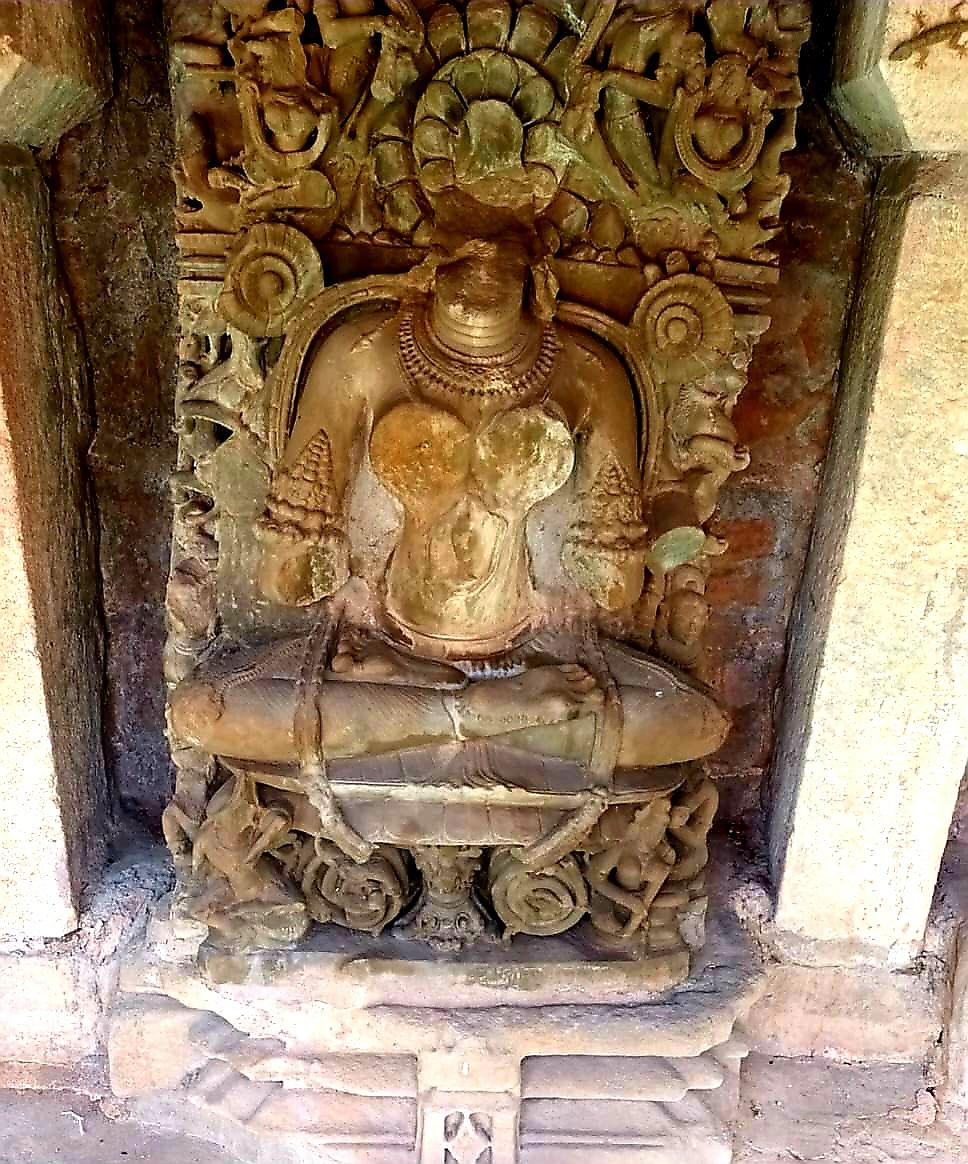
11. Yogini head, breasts & arms chopped
Towards the middle portion of the inner circle, the Gouri-Shankar Temple is located. According to available reports, it was constructed by Queen Alhanadevi of the Kalchuri Dynasty most probably of their Tripuri Branch in 1155 CE. Much information about the queen is not available and the aforesaid suggestion is made based on an inscription on a slab at the temple. Most probably it came up nearly two centuries after the original Chausath Yogini Temple. The sanctum sanctorum of the temple contains idol of God Shiva and Goddess Parvati riding on a bull (a rare combination) while outside the statue of a stone Bull is also located. As the Chausath Yogini Temple was severely vandalized during the Mughal period, it appears beyond comprehension that the Gauri-Shankar Temple remained undamaged while the Yoginis were so vandalized. In author’s view, a possibility cannot be entirely ruled out about the reconstruction/repair of the Gauri-Shankar Temple on a later date. Some scholarly accounts of historians and Indologists are also available suggesting aura of the temple, vintage and role of certain kings in its construction and Bhairava (dancing Shiva) as central deity at a certain point of time; however, this author does not want to delve upon these accounts unsure about their credibility.
Among the stone images of Yoginis, majority of them are properly named by the Archaeological Survey of India while some others remain unidentified. The eighty-one images represent Matrikas i.e. mother goddesses from an earlier time. Matrika is also called Mataras or Matri, a group of goddesses in Hinduism, variously depicted as a group of seven or eight i.e. Saptamatrikas or Ashtamatrikas. In the Hindu text Brihat Samhita, Varahamihira has described Matrikas as forms of Parvati taken by her with the cognizance of various deities commensurate with their names. So, these Yoginis (Matrikas) represent those deities and their divine energies; for illustration, Brahmani for Brahma, Vaishnavi for Vishnu, Maheshvari for Shiva, Indrani for Indra, Kaumari for Kartikeya, Varahi for Varaha, Chamunda for Chandi, Vinayaki for Ganesha, and so on so forth. In the Hindu Sect Shaktism and Tantra, the Yoginis have a significant role in that they are supposed to assist Parvati in her fight against demonic forces. Three remaining cells are represented by the images of Shiva (2 cells) and Ganesha (1 cell). As mentioned earlier, the majority of the surviving stone images have been badly damaged by the vandals, with face broken, trunk and limbs defaced or removed, and some surviving only from the waist down.
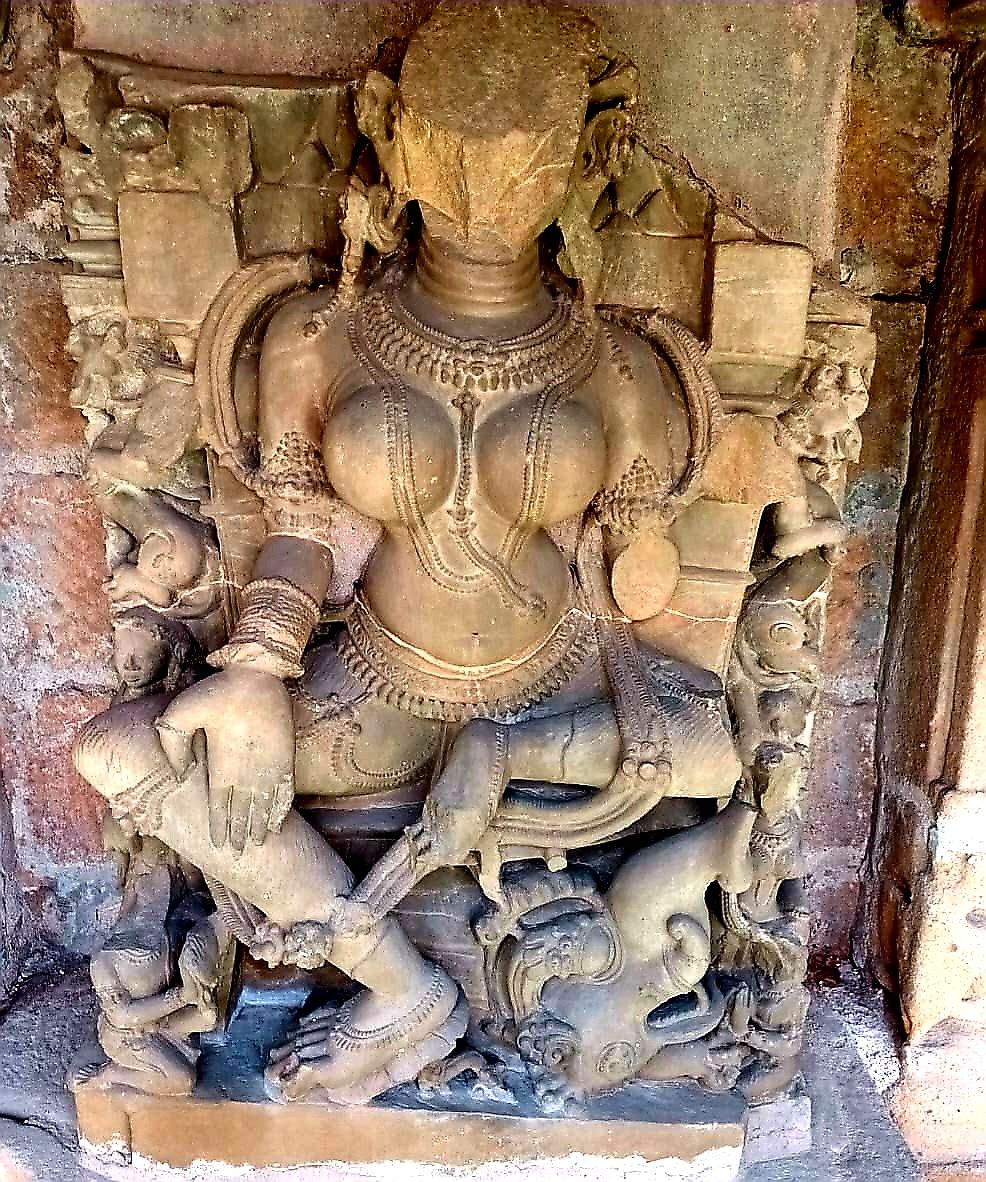
12. Yogini head erased & one arm chopped
Depiction of the nude body in the classic Indian art, be it human or divine, was not a taboo during the ancient and even early medieval times and the same could be observed through various arts and crafts particularly among the ancient temple sculptures and paintings. The female nude was a common subject particularly in temple sculptures artfully symbolizing sensuality and fertility. Such common examples are temples at Khajuraho in Madhya Pradesh as well as the caves of Ajanta and Ellora in Maharashtra. The depiction of the female nudity was often linked with the concept of Shakti, thereby symbolizing the feminine divine energy and creative power through such idols/images. One of the experts of Indian and south Asian Art, Vidya Dehejia has described Chausath Yoginis’ form as "mature, voluptuous beauties, generously endowed with ample hips and heavy melon-like breasts". These stone idols of female deities are bare down to the waist but heavily adorned with ornaments like earrings, necklaces, garlands, armlets, and bracelets. Then on their hips, they carry a jewelled girdle supporting rather frail ankle-length skirt. Notwithstanding, all Yoginis have attributes of divinity, with their faces and aura dignified, majestic and unsmiling, suggesting an aspect of Devi/Shakti.
Who is Accountable for Vandalism & Destruction?
According to a general opinion and belief, the Chausath Yogini Temple at Bhedaghat, Jabalpur, was targeted and vandalized by the Mughal invaders with the name of Emperor Aurangzeb appearing as the prominent suspect or definitive figure behind the attacks. According to the local versions and popular historical narrative, Aurangzeb's army attempted to desecrate and destroy the temple's idols, including the Gauri-Shankar Temple (exact time/year not known). They first attacked and vandalized the Chausath Yoginis and then approached towards the centre at the Gauri-Shankar Temple but their attempt was foiled by a divine intervention whereby a swarm of bees fiercely attacked the tyrants combined with a strong asthenic sensation in Aurangzeb's legs when he attempted to destroy the central shrine. The place in the vicinity of the River Narmada at Bhedaghat is still known for a large number of huge bee hives. Yet another local hearsay relates the destruction of the temple to the Islamic forces of Mohammed Gauri which appears a less reliable tale on the subject.
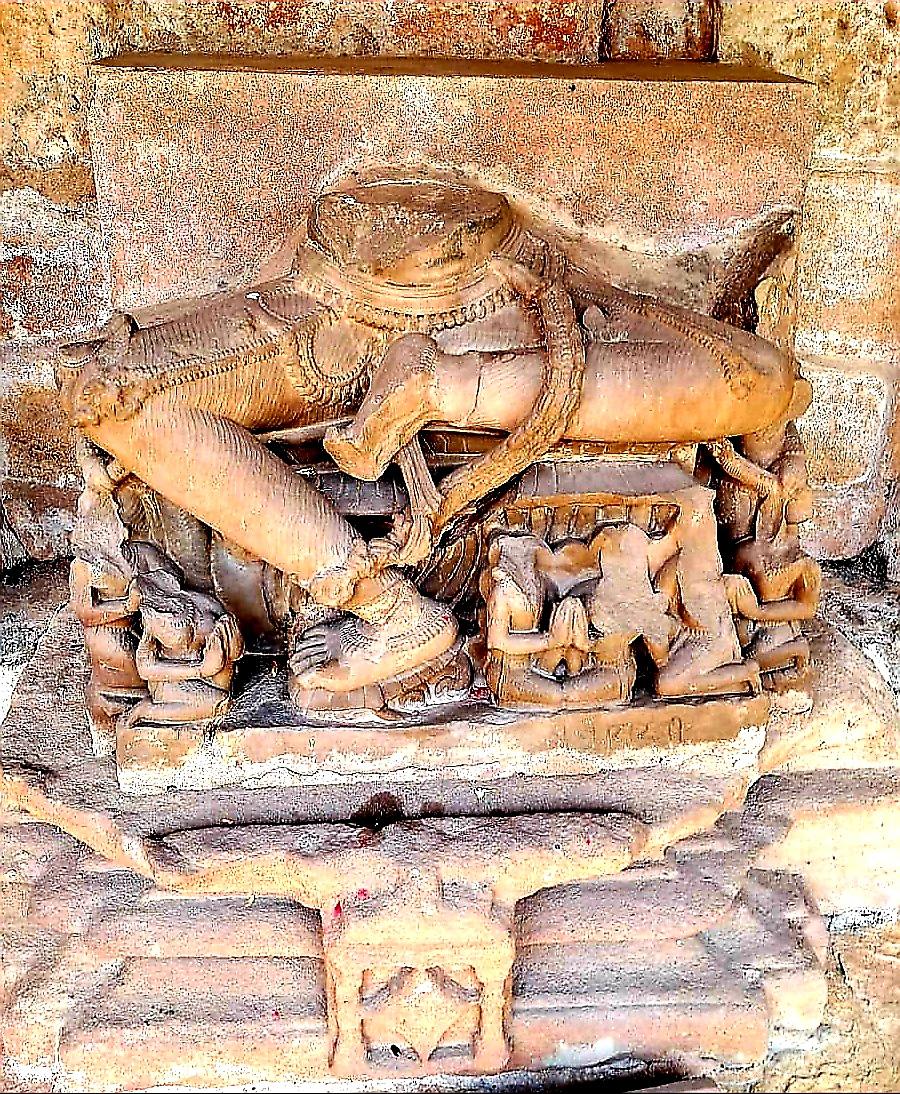
13. Yogini body above naval chopped
Among the Mughal emperors, Aurangzeb was the last effective as well as the most orthodox, bigot and tyrant ruler. He was one who had killed his own elder brother and legal heir to the Mughal throne Dara Shikoh, and imprisoned father Shah Jahan to become ruler with support of hardliner Sunni clergy and generals. His entire regime is a gory tale of persecution and atrocities of non-Muslims, mainly Hindus, that included massive executions, forced conversion and imposition of the rules and practices of orthodox Islamic state, such as the sharia and jizya, doubling of various taxes and duties on Hindus, etc. According to the historical accounts, as many as about 4.6 million people were killed during his regime besides destruction of thousands of Hindu/Sikh temples and shrines. There are enough imperial records and historiographies to vindicate that the iconoclastic frenzy of the bigot ruler led to the destruction of thousands of temples more so in the Northern India. Some of the major worship places demolished/desecrated under his orders include Vishvanath Temple in Varanasi, Somnath in Prabhasa, Keshav Rai in Mathura, Chintamani Parshvanath Jain temple at Ahmedabad, Siddha Gwali Temple at Gwalior, Gobind Dev Temple at Vrindavan, Someshwara Temple at Mewar, Ranganatha Swamy Temple in Karnataka, Pandarpur Temple in Maharashtra, Chausath Yogini Temple at Jabalpur, and so on.
However, this author is a little circumspect and skeptical about Aurangzeb’s role here. The main reason for this apprehension is the fact while there are sporadic war accounts of Gondwana rulers with the Mughal forces under Aurangzeb, the major battle around Jabalpur is recorded only between the Mughal forces of Emperor Akbar and handful fighters of valiant Rani Durgavati in 1564 CE. In the absence of a credible account including the time and date of destruction of this temple by Aurangzeb, the possibility cannot be entirely ruled out about the involvement of Asaf Khan at the behest of Emperor Akbar. In fact, data and references about the atrocities committed by the Muslim rulers including Mughal emperors on Hindu rulers and populace has been recorded on several websites along with the quotation of the original source. Some time back, the author had observed from the list of Hindu massacres on the Wikipedia that under the orders of Emperor Akbar, about fourty-eight thousand Rajputs and Hindu peasants were killed in 1560 CE (the historical event recorded as Massacre of Garha (now Narsinghpur District in MP). However, this data and information have been contested now by certain elements and, accordingly, the details are now removed this website. However, similar data and information about the Garha massacre is still available on several other websites such as kailaasa.org, dharmapedia.net, etc.
Actually, various historical accounts suggest that Akbar too was very intolerant towards Hindus and other non-Muslims during his early rule. Although Akbar is now considered more secular and moderate emperor yet he allowed slaying of scores of cows to sprinkle their blood onto the walls of the temples (Sir Henry Miers Elliot, The History of India, as Told by its Own Historians: The Muhammadan Period: Volume 5). During the post-independence age, Indian leftist historians have glorified Akbar as a moderate and tolerant emperor but he remains a contested figure from many historical accounts. He started Din-i Elahi in later life with the stated aim of communal harmony and had four prominent Hindus too as his ministers but it is also true that he was one to assume the title of Ghazi i.e. an Islamic warrior against infidels (non-Muslims). Some of the worst Hindu massacres occurred during his rule, the one at Chittorgarh being worst with about 30,000 civilian killings, including Jauhar (immolation) by about 8000 Rajput women out of the fear being enslaved. He is also known for patronizing begot hardliners like Shaikh Ahmad Sirhindi and Islamic historian Badauni, who constantly demanded for the blood of kafirs (Hindus). Portuguese Jesuit, Father Monserrate after visiting Akbar’s court wrote in his travelogue: “religious zeal of the Musalmans has destroyed all the idol temples…in place of the Hindu temples, countless tombs and little shrines of Musalmans been erected.”
Postlude
Recent visit to the Chausath Yogini Temple left an indelible mark on the psyche of this author along with a recurring thought of deep sorrow and pain. There is no doubt that had this been a contemporary violation of the Sanatana culture and faith, it would have generated an intense feeling of the outrage, anger and reprisal, instead. The author has endorsed a view on many occasions that the term religion imported from the West, in the topical context, essentially relates to the system of faith and belief of people while its corresponding Sanskrit/Hindu term Dharma essentially denotes the righteous duties and actions of the soul (person) based on the spirit of universal truth (Satya) and justice (Nyaya). What kind of religious ideology or thinking is this where the teachings and edicts of holy texts and teachers of certain religion(s) endorse and preach eternal hate and violence against other communities, their belief system, art and culture.
Many available instances and accounts in history suggest that the Islamic invaders and rulers destroyed thousands of temples and shrines in India during the last millennium and erected mosques on the same site in many cases using even the same construction material from the debris. The whole historical episode is a live testimony of religious abhorrence and consequent mass violence and vandalism where even the temple sculptures, symbols of faith, art and culture, was not spared following a war. It remains a puzzling mystery in the instant case as to why the tyrants and vandals desecrated and defaced the temple complex with idols partially in this case. The ASI has preserved the temple in the same condition till date without proposing or making any change. The obvious corollary that can possibly be derived from this sordid and sorrowful episode of history is that the subhuman perpetrators inter alia wanted to leave a permanent scar on the psyche and conscience of the future Hindu generations.
Images # 2 and 4 (c) KDS Parmar
All other images (c) Jaipal Singh
12-Jul-2025
More by : Dr. Jaipal Singh